#Queen Elizabeth Court
Text
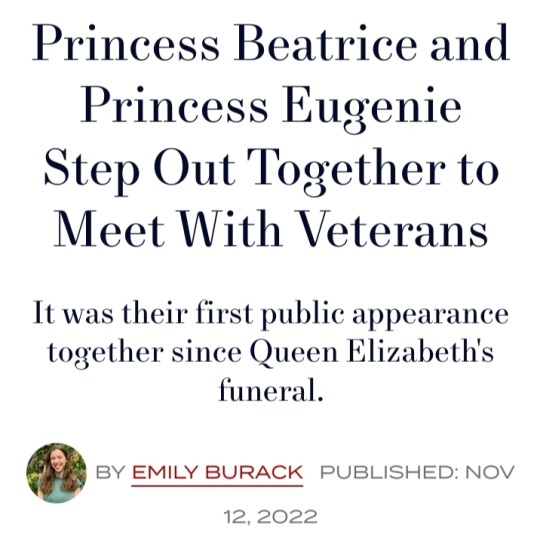
Royal sisters Princess Beatrice and Princess Eugenie are marking Armistice Day by visiting with veterans.
Eugenie shared on her Instagram (November 11) that they visited Royal British Legion Industries—a charity that provides vital care, welfare and employment services to Armed Forces veterans across the UK.
She wrote:
"We met incredible veterans who have completed RBLI’s #Lifeworks employability programme. It was wonderful to see the programme in action at the charity’s social enterprise factory which provides meaningful employment to veterans."
The two sisters then visited Queen Elizabeth Court, an assisted living facility. There, Eugenie writes:
"I also met Vi, who told me she served with my late Grandmother, which brought me such pride."
She ended her Instagram post with a tribute to veterans, writing:
"This Armistice Day we remember and pay tribute to the Fallen, the inspiring veterans and those currently serving in the Armed Forces across the world."
Both sisters affixed poppy pins to their jackets, which members of the royal family (and other Brits) typically wear during November to honor fallen troops.
The poppy comes from a poem "In Flanders Fields" by John McCrae, who wrote, "In Flanders' fields the poppies blow / Between the crosses, row on row..."



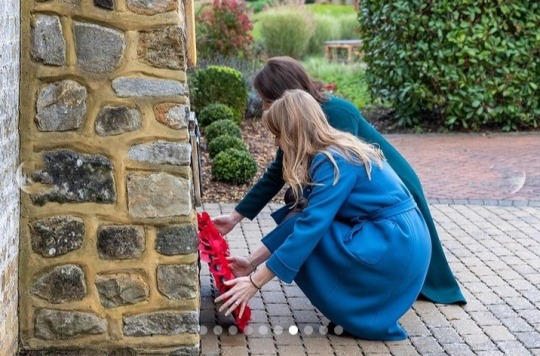



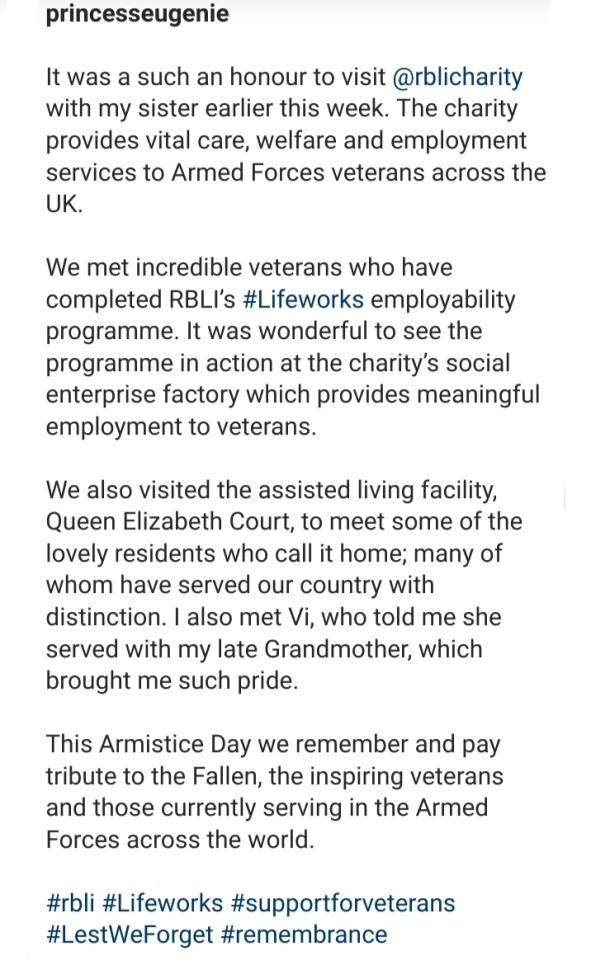
11 November 2022
(Beatrice is not on Instagram, but her husband, Edo Mapelli Mozzi, is on the platform.)
#In Flanders Fields#Princess Beatrice#Princess Eugenie#Armistice Day#Royal British Legion Industries#Queen Elizabeth Court#John McCrae#British Royal Family
1 note
·
View note
Text
"Administratively, too, [...] queens were considered the legal lords of their landholdings. [...] Grants noted that the queen's officials had administrative autonomy without being subject to the king or anyone else, and evidence of the same assumption can be gleaned from court rolls that were recorded with headings indicating the lord of the manor whose court proceedings were being enrolled. As an example, some court rolls for the manor of Haveringatte-Bower specified that it was the court of [Margaret of Anjou] that was in session, while later rolls recorded Elizabeth Woodville as the lord of the manor court."
-Michele Seah, 'My Lady Queen, the Lord of the Manor': The Economic Roles of Late Medieval Queens", Parergon, Volume 37, Number 2, 2020.
#queenship tag#margaret of anjou#elizabeth woodville#I really appreciated how Seah acknowledged the uneven surviving evidence for her subjects and how that affects her analysis.#It was very brief but it was more than what most historians do so it was very refreshing :)#my post#english history#this is for @ anon who asked if its true that Margaret mostly hosted her own courts while EW mostly stayed with her husband#I'm not sure which (if any) historian has said something like this* but I highly doubt it's true !#We don't really have solid itineraries in place for either queen to make any kind of firm conclusions of the sort#(ie: about their residences or anything else) though I'm sure it would have varied depending on the situation#But either way it's explicitly clear that both Margaret and Elizabeth held their own courts in their own lands on multiple occasions#And we also have evidence of both of them residing with their husbands in regular circumstances#*tbh this is too long to get into right now but this assumption does fit into the few 'revisionist' interpretations of both Margaret and EW#(which imo is just as degrading as her traditional interpretation for the latter) so I wouldn't be surprised if some#historians may have framed their situations in such a way and relied entirely on their own assumptions to do so#Either way as far as I know there is no evidence of any such contrast existing - at least not on a consistent basis.#and the evidence we do have contradicts the assumption#Hope this helps! I figured a proper excerpt from this article would clarify the point better than any direct answer from me <3#also in case anyone was wondering I *think* the title ('My Lady Queen the Lord of the Manor') was referring to administrative accounts#of EW based on what Seah wrote here - though ofc I'm not sure#queue
47 notes
·
View notes
Text
i really hate reading them 99% of the time because they're so hard to do well. and because everyone else usually focuses on the things i find least interesting about it.
but it's sooooo fun to imagine what your favorite characters would do as feudal lords. it's a fascinating question: what would this character do with unlimited executive and probably military power over an area of land and its people? people who depended on them? would they be a good ruler? a bad one? would they take it seriously? do their inherent qualities make them better suited to that role than the modern era? or are they truly a product of the time and place they come from?
because I'm me, this thought exercise is a chance to daydream about "what if I held a gun to this character's head and forced them to get involved in politics?", really.
on one end of the scale you have anakin skywalker, who would....not....have done well as emperor, or frankly as any kind of feudal lord. maybe don't give him more power over life and death, or taxes, or food supplies. maybe don't.
on the other end of the scale, you have jed bartlet, who i truly believe would have been more comfortable with unilateral authority and a divine mandate. somebody make that man a king. let his staff profess their undying devotion to him on their knees, the way they so desperately, secretly wish they could in canon. i feel like it would Fix Them. Leo McGarry wants soooooo badly to swear his sword to Jed. you know it in your heart to be true.
#alternate universe#fic ideas#ish#anakin skywalker#jed bartlet#not all stories are suited to this au#but many of them are#for instance in my continued madam secretary rewatch#i was thinking about 'what if we just crowned elizabeth mccord queen of something'#except you couldn't just have her be a member of a royal family straight up#obviously she starts as the sole surviving heir of some backwater fiefdom#that either already does or is forced to practice absolute primogeniture#and she does a great job#while still being loyal to the king (conrad)#whoooo lets say has to put down a rebellion of some kind#and ends up calling nobles back to court#ones he can trust and ones he can't#to shore up power#and elizabeth turns into some kind of ned stark esque figure#only with actual political instincts and ability to relate to people who are different from her#and it goes really really well
33 notes
·
View notes
Text
Royal Reads: Apr-Jun 2024
Note: Some of the following links are affiliate links, which means I earn a commission on every purchase. This does not affect the price you pay.


George VI and Elizabeth: The Marriage That Shaped the Monarchy by Sally Bedell Smith (new paperback version published Apr. 11, 2024) // Heroines of the Tudor World by Sharon Bennett Connolly (Jun. 15, 2024)



Six Lives: The Stories of Henry VIII's Queens by Charlotte Bolland, Suzannah Lipscomb, Nicola Clarke, Brett Dolman, Alden Gregory, Benjamin Hebbert, Nicola Tallis, Valerie Schutte (Jun. 20, 2024) // Revenge: Meghan, Harry, and the War Between the Windsors by Tom Bower (new paperback version published Apr. 16, 2024) // The Private Life of James II by Justine Ruth Brown (May 30, 2024)


The Waiting Game: The Untold Story of the Women Who Served the Tudor Queens by Nicola Clark (Apr. 25, 2024) // James VI, Britannic Prince: King of Scots and Elizabeth's Heir, 1566-1603 by Alexander Courtney (Jun. 3, 2024)



Wise Words from King Charles III by Karen Dolby (Apr. 25, 2024) // Hunting the Falcon: Henry VIII, Anne Boleyn and the Marriage That Shook Europe by John Guy, Julia Fox (new paperback version published Jun. 6, 2024) // Herod the Great: Jewish King in a Roman World by Martin Goodman (May 14, 2024)



Rasputin's Killer and his Romanov Princess by Coryne Hall (Jun. 15, 2024) // Catherine de' Medici: The Life and Times of the Serpent Queen by Mary Hollingsworth (Jun. 6, 2024) // Power and Glory: Elizabeth II and the Rebirth of Royalty by Alexander Larman (new hardcover published Apr. 30, 2024)



Stephen and Matilda's Civil War: Cousins of Anarchy by Matthew Lewis (May 30, 2024) // Courting the Virgin Queen: Queen Elizabeth I And Her Suitors by Carol Ann Lloyd (Jun. 30, 2024) // Babur: The Chessboard King by Aabhas Maldahiyar (Jun. 27, 2024)


Lady Charlotte Guest: The Exceptional Life of a Female Industrialist by Victoria Owens (Jun. 30, 2024) // Thorns, Lust and Glory: The betrayal of Anne Boleyn by Estelle Paranque (May 2, 2024)


The Palace: From the Tudors to the Windsors, 500 Years of Royal History at Hampton Court by Gareth Russell (new paperback version published May 9, 2024) // The Lost Queen: The Surprising Life of Catherine of Braganza, Britain’s Forgotten Monarch by Sophie Shorland (Jun. 6, 2024)



The Royal Palaces: Secrets and Scandals by Kate Williams, James Oses (Jun. 27, 2024) // The Mysterious Death of Katherine Parr: What Really Happened to Henry VIII's Last Queen? by June Woolerton (Apr. 4, 2024) // Izabela the Valiant: The Story of an Indomitable Polish Princess by Adam Zamoyski (Jun. 20, 2024)
#literature#affiliate links#royal history#king george vi#queen elizabeth the queen mother#king james vii and ii#king james vi and i#king charles iii#king henry viii#anne boleyn#prince felix yusupov#princess irina alexandrovna#catherine de medici#queen elizabeth ii#empress matilda#king stephen#queen elizabeth i#lady charlotte guest#hampton court#queen catherine#catherine parr
30 notes
·
View notes
Text

George Vertue FSA (English, 1684-1756)
The royal progress of Queen Elizabeth I, detail, ca.1740
#George Vertue#The royal progress of Queen Elizabeth I#English#English queen#england#english art#queen#fine art#art#european art#classical art#europe#european#fine arts#oil painting#europa#royal procession#royal progress#1700s#ladies#ladies of the court#english court#medieval
15 notes
·
View notes
Text

The Queen of Pentacles is a symbol of generosity and positive authority, intelligent and compassionate but with a touch of a love for the opulent , she is still an authoritative and will defend what she loves fiercely.
#tarot#Queen of Pentacles#Mrs. Suit#Tiffany Amber Thiessen#White Collar#Pentacles#Queens#minor arcana#Elizabeth Burke#Court Cards
32 notes
·
View notes
Text
Tfw you’re married to an dangerous unstable butcher and made queen to this guy and everyone at your court waits for you to die too and you have nightmares about this man killing you as he killed his wives so you hide your religion and placate and love him and keep yourself a secret as best as you can and do everything right but you’re still in torment with these dreams and their judgement and they give you his dead wives’ jewels and clothes and castles so you have to wear the gowns of a murdered child whom you can’t even admit was innocent because her name was dragged through the mud so much and just as you think you’ve achieved his love and reunited his family he paints his dead wife in your clothes on the royal portrait and she is in your clothes as if you are the ghost, alongside all the others who came after her and this was the woman he abandoned in childbed, and all of this happens to you smack bang in the middle of public so you can’t even rage or grieve smhhh
#look objectively i know that phillipa gregory can barely be called a historical writer but DAMN#catherine parr#kateryn parr#she was holding shit together in that court#tudor era#jane seymour#katherine howard#catherine howard#henry viii#the taming of the queen#phillipa gregory#I WOULD’NT reccommend this book btw! you don’t need to read it!#its a barebrush detailing of kateryn parr but the ending is so wildly inane and i HAAATE thomas seymour and how they portrayed elizabeth#house of tudor
20 notes
·
View notes
Note
Sorry for being annoying over Anne x Jane but if you ever would have the chance to adapt this ship how would you do it?
by ‘adapt’, do you mean for a dramatisation? because i strictly believe that we need to put a moratorium on tudor related media (excluding henry vii and maaaaybe mary i since they’re underrepresented as is, and it would annoy the right people). so i don’t want an adaptation, frankly.
as for an ideal adaptation… well, i liked the idea of anne and jane’s dynamic in wolf hall — but not anne’s characterisation. it was so belligerent in stripping her of warmth and humanity, and this collective amnesia about criticisms of mantel’s handling of women (and gender) now that she’s dead is really something. personally, i’m fine with violently and bodily shoving her from her pedestal. on a similar strain, channel 5’s anne boleyn tried to give us a similar dynamic — of anne being unsettled by jane, whilst simultaneously looking down at her, and (again) i like the idea of anne being curious about jane, and the dynamic of gender/femininity being played with, with the two being seemingly polar opposites in ideological opposition, but nothing was delivered on that front. for as much as lola talked about jane being ‘machiavellian’... literally nothing was shown really exploring that. the kiss felt like everything else in that show: hollow, trying to be reactionary. you can’t try to explore that dynamic and simultaneously refuse jane any characterisation beyond the periphery of anne’s perspective; it’s imbalanced. also, i don’t like how these adaptations take every opportunity to make anne abusive to others — she is always depicted as putting her hands on jane (as well as striking others) and anne boleyn (channel 5) has her sexually harassing jane. i am not opposed to depicting anne as violent or abusive (there’s arguably evidence for it) but it seems notably one-sided: jane dormer’s account implies jane gave as good as she got (“scratching and bye blows between the queen and her maid”), and jane was clearly willing to undermine and displace her mistress which contradicts the idea of jane as passive/complacently honourable.
arguably the tudors s2 threads the needle the best? anne is irascible and clearly agitated and unsettled by jane, who is shown to be actively involved in her faction, and evidently lacks respect for anne. it just doesn’t take it far enough on characterising jane/giving her a clear motivation, and walks all of it back by s3, anyway.
#i know this isn’t really what you asked but honestly idk how to adapt this bc it depends on the framework of the overall adaptation#like … in the seymour adaptation you (i believe it was you) asked about ... this might play out differently#because from a seymour perspective court is opportunism and competition in a context where the sands are rapidly shifting underneath you#within a family that is exceptionally unexceptional really.#and anne is perhaps never legitimately queen in that context. but likewise coa's legitimacy can be traded for advancement.#from jane’s perspective anne is potential this questionable sister role as they come to court and serve together#functionally forced into the same spaces and roles until they’re not and that causes jane instability and it’s caused by anne.#anne is the obstacle. and then anne becomes the ritual sacrifice. because court is opportunism and sacrifice and it's her or you.#but from anne’s perspective i doubt jane means anything. they are not close nor familial; they seem to share nothing#(other than potentially elizabeth seymour...)#jane doesn't seem to be present in the devonshire manuscript for example.#jane x anne#anne x jane#seymour adaptation tag
9 notes
·
View notes
Text
Had circumstances been just a little different, Anne Boleyn might still have lived. Had she produced a son, Jane would have been a passing distraction, Anne's enemies would have been silenced, and her fiery character might again have seemed, at least at times, beguiling to Henry. During the course of their brief marriage, which lasted just over three years, there had been many fluctuations. After the final miscarriage, Anne fought back, saying she had been frightened by Henry's accident, but also broken-hearted at his paying attention to another woman. This kind of criticism was not something Henry was prepared to tolerate in a wife; one of Katherine's strengths, as she herself acknowledged, was that she had never shown any sign of animosity or distress in response to the king's infidelities. Henry and Anne's relationship had been a genuine love-match, however, and the volatility which helped bring about the extraordinary events of the break with Rome remained a part of their relationship ever after.
Henry VIII, Lucy Wooding
#'never' is doing a lot of heavy lifting/ obfuscating here lol#(it's traditionally thought that she never had harsh words about bessie blount-- and indeed there's no record of this--#although elizabeth blount's primary biographer has said that she had no court presence after the birth of henry fitzroy suggests a frosty#dynamic... just about the elevation of fitzroy#however there's the hastings drama)#also 'her enemies would have been silenced' is overly simplistic#unpopular queens having sons might have reduced overt hostility#but it didn't annihilate it. more realistically might have 'bridled' her enemies#and yet i still find this excerpt compelling so . here we are#lucy wooding#last part of sentence 2 tho...eminently plausible#prior to this storms always melted into sunshine . stormclouds gathered on the horizon and storms began again. then repeat.#and as reviled as the assertion 'genuine love-match' has been as of late. there is evidence which supports it .#would jane have been a passing distraction? again we don't know. their periods of 'royal mistress' (although there needs to be a better ter#maybe...object of king's affections?) are different in that there is only record of anne's in hindsight via cavendish etc#and also in their actions. in 1526 there was no royal watcher that believed the withdrawal of one of the queen's ladies was significant#in 1536 there was one who believed jane's meetings with henry were highly significant and they proved to be...#altho as wooding underlines here they proved to be mainly due to circumstance#it's not to say there weren't discussions behind closed doors of anne becoming queen among the boleyns circa 1526. but they were not known#and wouldn't have been guessed due to lack of precedent
10 notes
·
View notes
Text
Derby Square. Lomo LC-A. Kentmere 400.
It was in 2021 when I first posted photos of Derby Square here. It remains one of my favourite places in the city as the contrast between the Victoria Monument and Queen Elizabeth II Law Courts is quite striking. There is a historic picture of this area after World War 2 that shows it pretty much flattened except for the memorial.
As the weather was good and I had the LC-A in my pocket I took the opportunity to snap a few frames when i walked past in April.


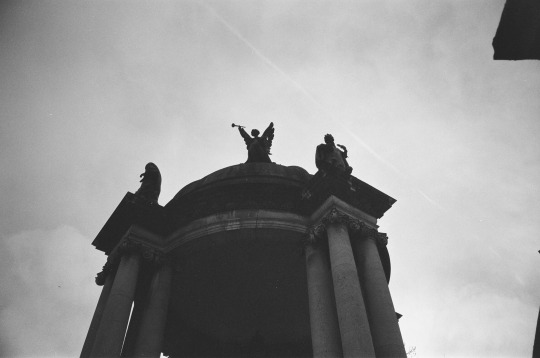







#liverpool#liverpoollomo#lomo#lomography#analogue photography#lomo lc a#lomo kompakt automat#russian camera#kentmere 400#ilford film#35mm film#black and white film#400 iso#derby square#victoria monument#Queen Elizabeth II Law Courts#liverpool city centre#merseyside#film is not dead#don't think just shoot
2 notes
·
View notes
Text
fic question: which is less confusing/ambiguous - "the queen mother" or "the dowager"? or is there something else i should go with?
(the scene features a different queen who is also a mother and i just want to be sure it's clear who is being referred to.)
#i'm leaning towards dowager cos i was at uni before i realised “the queen mother” wasn't just posh for “the _queen's_ mother”#(hashtag just the-very-long-reign-of-elizabeth-the-second things!)#and in this fic sif is a queen and a mother and idk how clear it is that it's not about her#it's in a dialogue and i can't really stop and clarify to the reader Because Pacing#and frigga's son calling her by her first name in a formal/court context just seems weird to me?
6 notes
·
View notes
Text

I love how that one dude decided to go for an entirely different style of fashion than anyone else at the ball, he was like you know what if i'm gonna have to cross dress I might as well be original about it wth
#i feel like his inspiration was the fashion of an entirely different court but i don't know which one#also i'm cackling at Razumovsky's face here#he's like 'you know those damn bishops are gonna piss my queen off again and then what? i'm not dressed to argue right now!'#they really did capture the vibe of everyone but elizabeth finding those balls akward as hell and i find it hilarious tbh
2 notes
·
View notes
Text
The division between the two families [the Woodvilles and the Nevilles] and their allies can be seen in the royal charters that they witnessed. Warwick, Rivers and Archbishop Neville of York, while serving as chancellor and afterwards, were fairly constant witnesses to royal charters and consequently often appeared together. This was not, however, the case for other family members and friends. From 1466 to 1469, if Scales or Woodville associates like Sir John Fogge, John Lord Audley or Humphrey Lord Stafford of Southwick witnessed royal charters, then members of the Neville group, such as John Neville, earl of Northumberland, or John Lord Wenlock would not, and vice versa. Discounting the ubiquitous Warwick, Rivers and Archbishop Neville, of the twenty-four charters issued between February 1466 and June 1469, twelve were witnessed by men associated with the Woodvilles, eight by men associated with the Nevilles and two were witnessed by no member of either group beyond the two earls at their heads and the archbishop; only two charters, both from 1466, featured associates of both families.
Such striking segregation of witnesses suggests that something more than simple convenience or availability was at play. [...] The evidence of these witness lists does show the extent of the split between the two groups from early in Edward's [first] reign and of the need for political society to work with that cleavage in the heart of the Yorkist regime."
-Theron Westervelt, "Royal charter witness lists and the politics of the reign of Edward IV"
*This is specifically applicable for Edward IV's first reign; in contrast, the charters in his second reign displayed a great deal of aristocratic and domestic unity and cohesion.
#the woodvilles#edward iv#wars of the roses#richard neville 16th earl of warwick#my post#elizabeth woodville#Obviously I hate the idea of Elizabeth and her family being seen as a social-climbing invasive species who banished the old nobility and#drove Warwick/Richard into rebellion and dominated the government and controlled the king and were responsible for Everything Wrong Ever#but I also dislike the 'revisionist' idea that they were ACTUALLY just passive and powerless bystanders or pawns who kept to their#social “place” (whatever the fuck that means). Frankly speaking this is more of a diminishment than a realistic defense.#the 'Queen's kin' (as they were known at the time) were very visible at court and demonstrably influential and prominent in politics#and as this shows there DOES seem to have been a genuine division/conflict between them and the Nevilles during Edward's first reign#(which DID directly lead to the decline of Neville dominance in England though the maintained honored positions and influence of their own)#Especially since Edward's second reign was entirely void of any such divisions - instead the nobility were united and focused on the King#even Clarence and Gloucester's long and disruptive quarrel over the Warwick inheritance never visibly left its mark on charters#so the Woodville/Neville divide from the 1460s must have been very sharp and divisive indeed#And yes it's safe to say that Elizabeth Woodville was probably involved: whether in her own right or via support of her family - or both -#it's illogical to argue that she was uninvolved (even the supportive Croyland Chronicle writes that Edward was “too greatly influenced”#by her; she and her family worked together across the 1470s; she was the de-facto head in 1483; etc)#Enhanced by the fact that Elizabeth was the first Englishwoman to be crowned queen - meaning that the involvement of her#homeborn family marked the beginning of “a new and largely unprecedented factor in the English power structure” (Laynesmith)#This should be kept in mind when it comes to analyzing contemporary views of them and of Elizabeth's own anomalous position#HOWEVER understanding the complexity of the situation at hand doesn't mean accepting the traditionally vilified depiction of the Woodvilles#Warwick and the Nevilles remained empowered and (at least outwardly) respected by the regime#Whether he was driven by disagreements over foreign policy or jealousy or ambition - the decision to rebel was very much his own#Claiming that the Woodvilles were primarily responsible is ridiculous (and most of the nobility continued to support Edward regardless)#There's also the fact that Warwick took what was probably a basic factional divide and turned it into a misogynistic and classist narrative#of a transgressive “bad” woman who became queen through witchcraft and aggrandized a family of social-climbing “lessers” who replaced#the inherently more deserving old nobility and corrupted the realm - later revived and intensified by Richard III a decade later#ie: We can recognize their genuine division AND question the (false/unfair) problematic narrative around the Woodvilles. Nuance is the key.
10 notes
·
View notes
Text
Closing the 1720s for now -

1720s Barbara Ivory (d.1748), Mrs Henry Davenport III by Charles d' Agar (Lacock Abbey, Fox Talbot Museum and Village - Lacock, near Chippenham, Wiltshire, UK). From artuk.org 1517X1889.

1721 (after) Tsarevna Anna Petrovna by Ivan I Grigoryevich Adolsky (Hermitage). From arthermitage.org-Ivan-I-Grigoryevich-Adolsky-Portrait-of-Tsarevna-Anna-Petrovna.html 1173X1475.

ca. 1728 Anna Karolina Orzelska by Antoine Pesne (Muzeum Narodowe w Warszawie - Warszawa, Poland)). From Wikimedia 1500X2267.
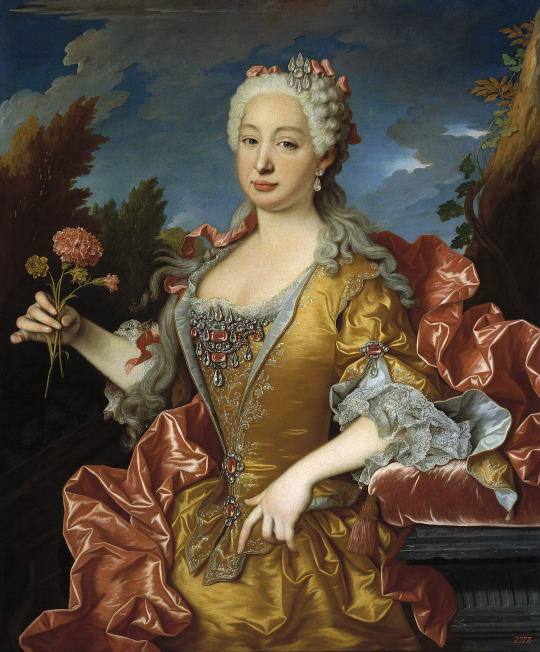
ca. 1729 Queen Maria Barbara of Spain, née Portugal by Jean Ranc (Museo del Prado - Madrid, Spain). From their Web site; fixed spots w Pshop 2445X2953.
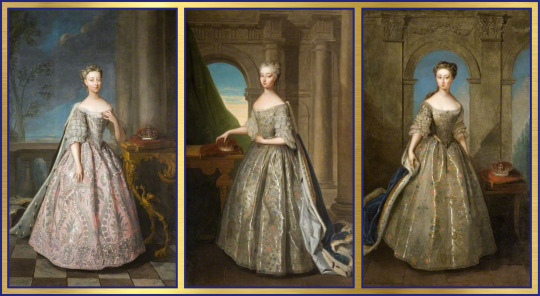
1728 Princess Amelia Sophia, Princess Royal Anne, and Princess Caroline Elizabeth by Philip Mercier (all three at the Hertford Magistrates' Court - Hertford, Hertfordshire, UK). From tumblr.com-search-18th+century 1996X1093.
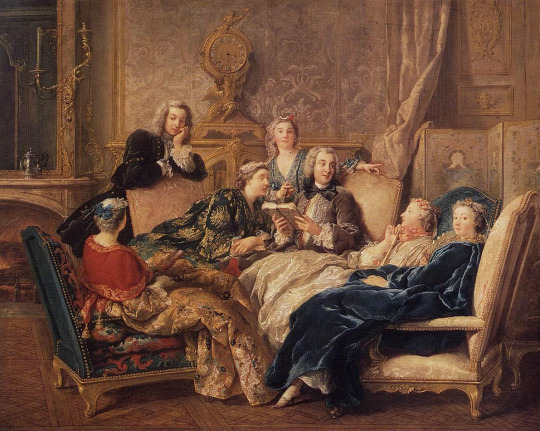
1729 A reading of Mollière by Jean-François de Troy (location ?). From Wikimedia 1191X950.
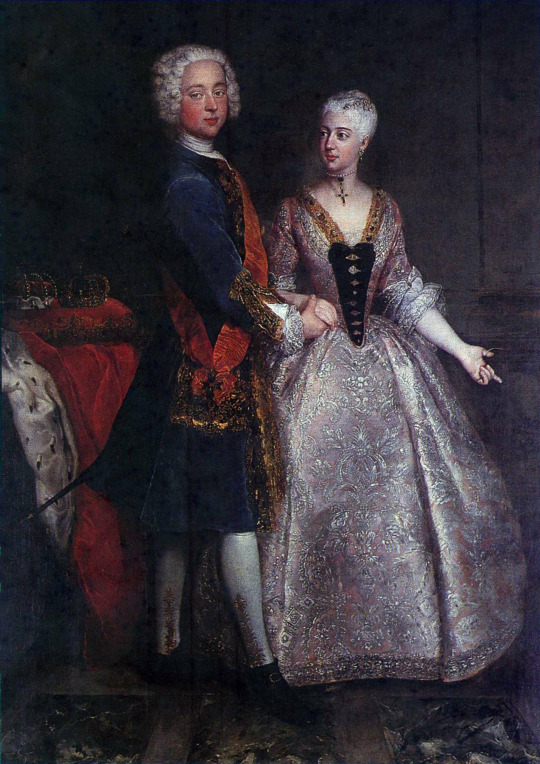
1729 Wedding portrait of Friederike Luise and Karl Wilhelm Friedrich by Antoine Pesne (Schloss Charlottenburg - Berlin, Germany). From Wikimedia 1400X1980.
#1720s fashion#Rococo fashion#Georgian fashion#Louis XV fashion#Barbara Ivory#Charles d' Agar#Anna Petrovna#Ivan I Grigoryevich Adolsky#court dress#Anna Karolina Orzelska#Antoine Pesne#Queen Maria Barbara of Spain#Jean Ranc#Princess Amelia Sophia#Princess Royal Anne (1709 – 1759)#Princess Caroline Elizabeth#Philip Mercier#Jean-François de Troy#robe volant#Princess Friederike Luise#wedding dress
12 notes
·
View notes
Text
Hans Holbein, Holbein at the Tudor Court, Queen's Gallery, London, 2024


















#hans holbein the younger#Queen's Gallery#buckingham palace#london#painting#tudor court#thomas more#jane seymour#anne boleyn#edward vi#elizabeth i
5 notes
·
View notes
Text

The set arrived in the Queen’s jewelry box in the mid 1980s. Leslie Field notes, “As recently as 1985, on a State visit to England, the Amir of Qatar presented the Queen with a diamond swag necklace with a centerpiece of two large rubies.” The Amir of Qatar in question is Sheikh Khalifa bin Hamad Al Thani, who served in that role from 1972 to 1995. The necklace was accompanied by a coordinating pair of earrings.
The Queen began wearing the demi-parure, which features cabochon rubies placed among diamond floral and festoon motifs in a yellow gold setting, shortly after she received the gift. Above, she wears the set in Madrid in 1988, pairing it with one of Queen Victoria’s Wheat Ear Brooches (worn as a hair ornament) and an interesting ruby and diamond bracelet. - The court jeweller

In June 1992, she brought the rubies with her on a state visit to France. She wore them with the Burmese Ruby Tiara and her Art Deco-style ruby and diamond bracelet for a dinner at the Élysée Palace in Paris during the trip.
Interestingly, the Queen has chosen to wear the ruby set on two occasions for the State Opening of Parliament. Here, she wears the rubies for the event in November 1990.

and here, she wears them as she delivers her speech from the throne during the State Opening in November 1994.
39 notes
·
View notes